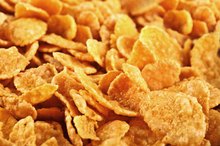What does fact checked mean?
At Healthfully, we strive to deliver objective content that is accurate and up-to-date. Our team periodically reviews articles in order to ensure content quality. The sources cited below consist of evidence from peer-reviewed journals, prominent medical organizations, academic associations, and government data.
- Journal of Clinical Endocrinology and Metabolism: Effect of Exercise Intensity on Glucose Requirements to Maintain Euglycemia During Exercise in Type 1 Diabetes.
- Journal of Clinical Endocrinology and Metabolism: Effect of Exercise Intensity on Glucose Requirements to Maintain Euglycemia During Exercise in Type 1 Diabetes.
The information contained on this site is for informational purposes only, and should not be used as a substitute for the advice of a professional health care provider. Please check with the appropriate physician regarding health questions and concerns. Although we strive to deliver accurate and up-to-date information, no guarantee to that effect is made.
Does Aerobic Exercise or Lifting Weights Burn More Carbs?
Your body draws the energy to power your workouts from different sources. Fat is a big source, as are carbohydrates. Aerobic workouts use a mix of carbohydrates and fat, depending on the intensity of the workout. Weightlifting workouts, on the other hand, use primarily carbohydrates as fuel. Aerobic workouts tend to use more energy overall than weightlifting, meaning they drain your carbohydrate stores more.
How Muscles Use Carbs
The carbs you eat are not the same thing that your body uses to power your muscles. In order to make them usable, the carbs you eat have to go through a transformation. Your body strips them down to a simple sugar, glucose. Glucose floats around your bloodstream and your muscles absorb it to store and use as fuel.
Glucose is stored in your muscles as glycogen; you can access this fuel in case your blood sugar levels drop between meals. Your liver also stores glycogen so that you don't run out of energy every time you skip a meal.
When you workout, glucose helps power your muscles. Your body can break it down to create energy and you use that energy during your workouts. It's one of the major sources of energy.
- The carbs you eat are not the same thing that your body uses to power your muscles.
Anaerobic Workouts Vs. Aerobic
The Digestive & Circulatory Systems Converting Food Into Energy
Learn More
Aerobic workouts are activities like jogging, swimming, cycling and circuit training 3. When you do an aerobic workout, it usually lasts between 30 and 60 minutes, and sometimes more depending on your fitness level. You move constantly and take very few breaks.
Weightlifting, on the other hand, is an explosive activity. You do sets with maximum intensity but very few reps, usually fewer than 20. That means you concentrate all of the energy you use into a few exercises.
Weightlifting workouts are considered anaerobic. The terms "aerobic" and "anaerobic" refer to the way your body fuels the workout. Aerobic workouts use oxygen to make energy out of carbohydrates and fat. Anaerobic workouts don't use oxygen to create energy.
Calling a workout "aerobic" or "anaerobic" is slightly misleading because your body is always using both systems to make energy. However, one system will dominate the other, depending on the type of exercise you do 1.
- Aerobic workouts are activities like jogging, swimming, cycling and circuit training 3.
- Calling a workout "aerobic" or "anaerobic" is slightly misleading because your body is always using both systems to make energy.
Workout Intensity
The intensity of your workout determines the type of energy you use. Weightlifting workouts are very intense and demand quick bursts of energy. The anaerobic system delivers energy quickly but it doesn't last for long, which is why you need breaks.
Weightlifting workouts naturally force you to take breaks. Even if you're only doing 20 or 30 seconds of work per set, you use an incredible amount of energy in that short amount of time. The drawback to using all of that energy is that your body produces copious amounts of lactic acid.
Lactic acid is produced when your body breaks down blood sugar to produce energy. If lactic acid builds up faster than your body can get rid of it, you'll have a hard time using carbs for energy. A buildup of lactic acid prevents your body from turning sugar into energy, which is why heavy weightlifting sets don't last very long.
- The intensity of your workout determines the type of energy you use.
- A buildup of lactic acid prevents your body from turning sugar into energy, which is why heavy weightlifting sets don't last very long.
Aerobic Energy Sources
When Does the Body Start to Use Muscle Tissue for Energy?
Learn More
Aerobic workouts aren't as intense, so your body has more time to make energy. When your body makes energy using oxygen it's more efficient, but the process takes longer, so it doesn't work well when you need big bursts of energy.
Aerobic workouts use a mix of fat and carbs, depending on your intensity. Fat gets utilized more in lower-intensity workouts. It's an abundant source of energy in your body, but it takes longer to break down than carbohydrates, which is why your body prefers carbs as the main fuel source when you do intense aerobic exercise.
The intensity of a workout is different for everybody. For aerobic workouts, the intensity is measured by something called VO2 max, which stands for the maximum amount of oxygen you can use during a workout.
When you go above 75 percent of your maximum oxygen intake during a workout, carbohydrates become your main source of energy, according to a 2014 research paper published in Sports Medicine.
- Aerobic workouts aren't as intense, so your body has more time to make energy.
Overall Energy Cost
Weightlifting workouts are more reliant on carbohydrates as fuel than aerobic workouts because the intensity is higher. However, aerobic workouts still use a lot of carbohydrates. In fact, they use much more energy in general than weightlifting.
Calories are a measure of energy that's used to determine how much fuel you burn in a workout. According to MyPlate, a 154-pound man will burn 440 calories in an hour of weightlifting, as opposed to 590 calories burned in an hour of running.
The disparity means that, if you do each activity for the same amonut of time, aerobic exercise takes more energy. If the intensity of the aerobic workout is around 75 percent or above of your VO2 max, you'll burn most of the energy in the form of carbohydrates, which means that you'll use more than in a weightlifting workout.
- Weightlifting workouts are more reliant on carbohydrates as fuel than aerobic workouts because the intensity is higher.
- If the intensity of the aerobic workout is around 75 percent or above of your VO2 max, you'll burn most of the energy in the form of carbohydrates, which means that you'll use more than in a weightlifting workout.
Weightlifting Workout Benefits
If the intensity is high enough, an aerobic workout burns more carbs than a weightlifting workout does. But both affect carb storage and blood sugar levels. Your muscles are the biggest storage site for glucose in your body. When you do a weightlifting workout they lose a lot of precious energy and need to restore their sugar supplies.
After a workout your muscles become very welcoming of any sugar floating around your bloodstream and quickly snatch it up, keeping your blood sugar levels from spiking. In this sense, weightlifting is a very effective way to control your blood sugar levels and burning excess carbohydrates.
- If the intensity is high enough, an aerobic workout burns more carbs than a weightlifting workout does.
- In this sense, weightlifting is a very effective way to control your blood sugar levels and burning excess carbohydrates.
Related Articles
References
- University of Michigan Medical School: Timing is Everything: Why the Duration and Order of Your Exercise Matters
- University of New Mexico: Glycogen and Resistance Exercise Training
- GSSI: MUSCLE ADAPTATIONS TO AEROBIC TRAINING
- Journal of Clinical Endocrinology and Metabolism: Effect of Exercise Intensity on Glucose Requirements to Maintain Euglycemia During Exercise in Type 1 Diabetes.
- Cleveland Clinic. Aerobic Exercise.
- Metabolism. MedlinePlus.
- How Much Physical Activity Do Adults Need? Centers for Disease Control and Prevention.
- Target Heart Rate and Estimated Maximum Heart Rate. Centers for Disease Control and Prevention.
- Milioni F, Zagatto A, Barbieri R, et al. Energy Systems Contribution in the Running-based Anaerobic Sprint Test. International Journal of Sports Medicine. 2017;38(03):226-232. doi:10.1055/s-0042-117722.
Writer Bio
Henry is a freelance writer and personal trainer living in New York City. You can find out more about him by visiting his website: henryhalse.com.









